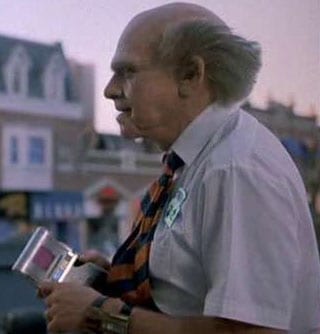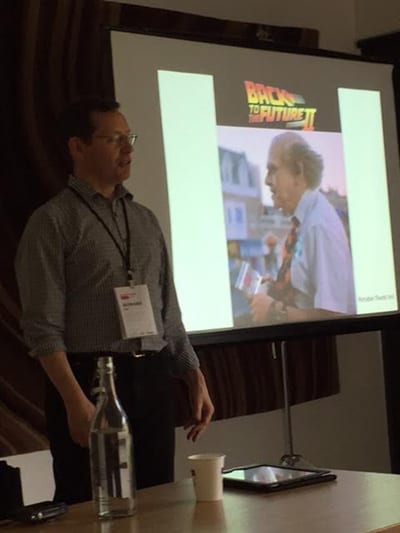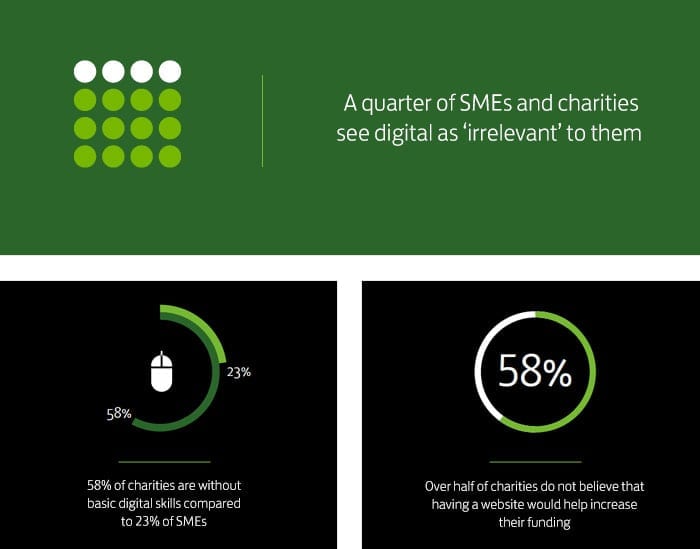Roads… where we’re going we don’t need roads
This is what Dr Emmett Brown said to Marty McFly in the Spielberg movie Back to the Future before they climbed into the DeLorean time machine heading for 21 October 2015.
Released in 1985 BI (before internet), Back to the Future painted a picture of what life would be like this year. It predicted no need for roads as we would be jetting around in flying cars; for shorter journeys ‘the youth’ would be hovering around on hover boards, electronics would be part of clothing, enabling, amongst other things for shoelaces to tie themselves, as well as components in other household items, like self emptying rubbish bins.
There was even a portable thumb unit to collect donations (Marty was asked to give $100 to save the Hill Valley Courthouse) and other transactions (Fred the taxi driver had one to collect fares).

Terry and Portable Thumb Unit in Back to the Future II. Source: Backtothefuture.wikia.com
We simply cannot predict the future
The Back to the Future team may have predicted some themes, but they didn’t get it totally right. And that is exactly the point. We simply cannot predict the future.
Last week I was at ecampaigning forum (ecf), where digital campaigners, volunteers and fundraisers gathered expectantly at Oxford’s Keble College hoping for the answer to the next big thing. Alas, the surroundings were more reminiscent of a scene from a Harry Potter film, and delegates had more hope of finding a werewolf-slaying silver bullet than the answers to the many and varied problems that NGOs are facing today – and will face in the future.

Howard Lake on the Portable Thumb Unit at ECF, Keble College, Oxford, April 2015
Listening to sessions about the future of digital fundraising, campaigning, volunteering, communications and marketing, I was struck by just how fast the digital world is moving. A year ago we had no experience of the power of viral campaigns including #nomakeupselfie and #icebucketchallenge. Today, in response, some of the forward thinking charities have created roles with the sole remit of spotting and acting on opportunities outside of their organisations that are yet to happen and as yet unknown.
That in itself is a massive change in approach, but an important one as the pace of technological development is not going to slow down any time soon. The things you take for granted today; your job, the skills you need, the lifestyle you lead will change over the next few years. In fact you can probably think of some of these changes you have already experienced in the last 10 years.
Many of the most popular jobs in 2015, including ‘digital fundraiser’ and ‘app developer’ didn’t exist 10 years ago and the skills needed today to do these new jobs continue to change too. This means that to thrive, you too must change. You too have to be able to understand the environment that you live and work in, spot opportunities and constantly adapt.
Fundraising is changing
Within fundraising, as the world changes around us, the most effective ways to fundraise are also changing. Opinions on best practice have shifted and will continue to do so. For example;
* Three years ago a like on Facebook was something to rejoice over, then months later it became a bad thing, labelled ‘slactivism’, liking something was seen as an alternative for other support, like making a donation. There was a fear that if a person merely liked something they may consider that they had done their bit, and their bit had made no impact.
Unicef Sweden ran a ‘likes won’t save lives’ campaign to help communicate this message.
[youtube height=”450″ width=”800″]https://www.youtube.com/watch?v=MfzHczHKRIc[/youtube]
Last month JustGiving’s Slacktivism; monster or myth report highlighted evidence that if someone likes something they are more likely to go on and do something else for that cause. A like is no longer viewed as an alternative for donating but a good thing, (hurray) a first step in a longer relationship with an organisation or cause that a person cares about.
* The perceived wisdom is that people have no time to look at emails so to make them as short as possible. Several delegates at ecf commented how they had tested longer email copy with great success, they thought long copy was different, stood out and was more meaningful than the other hundreds of short emails that people are bombarded with every day.
They cited a trend that was working for them involving more in depth, informative, documentary journalism style of copy.
* The same applies to video content; it is commonly believed that you should make your video short, for example less than two minutes. Then along comes Kony as long ago as 2012 with a 30 minute film that has received over 100 million views and 1.4 million likes on YouTube. There appears to be a trend for more journalistic video content, yet at the same time anything with a kitten in a bow tie gets viewed a lot too.
Unpicking and understanding what is happening right now can seem baffling so why there is any expectation to know what the next big thing is, is beyond me.
[quote align=”center” color=”#999999″]when it comes to predicting likely future trends we need to be in the present[/quote]
What is happening right now provides indications about the future I’m not saying that it is not important to learn from the past, but when it comes to predicting likely future trends we need to be in the present.
Just look around you, we all have phones, most people have a smart phone, a Tecmark survey in 2014 found the average user picks up their smartphone 221 times a day. According to Digital Spy three quarters of us use our phones on the toilet, and I think its more than that because that figure does not account for those of us that choose not to admit it in a survey.
What are the trends, that haven’t affected you yet? What are the regulatory, economic, legal, technological and social issues that are likely to affect your charity in the future? For example, if consumers are purchasing more by mobile, if this trend continues to grow, what impact would this have on your fundraising? If you knew that mobile was going to be the only method of payment in the future, what would you need to do to be ready in one year from now? If house prices or interest rates are going up what does that mean for your supporters? How will the rise in interest rates affect your donors, your beneficiaries or your suppliers?
Get into the habit of spotting what is happening by keeping up with social, economic and environmental trends. All things are connected so what is happening today will inform future trends. Read newspapers and magazines. Read popular blogs. Watch TV, not just the news, but popular shows.
CTR Photos / Shutterstock.com
Advertisement
Big data
Consider Big data; defined as extremely large data sets, for example from phones, credit cards, televisions, computers that may be analyzed to reveal patterns, trends, and associations, especially relating to human behaviour and interactions. Whether you find it helpful or creepy this new use of data opens up some incredible insights and opportunities;
* Google has analyzed search terms clustered by region in the US to predict flu outbreaks faster than hospital administration records.
* Target in the US infamously used an algorithm, that tracked purchases of items such as unscented lotions to detect when women were pregnant and offered discounts to them.
* Propeller Health in the US conducted tests with asthmatic school children. A GPS sensor in their inhalers recorded their location whenever they used them. The aggregated data showed proximity to a refinery aggravated their asthma. A simple solution of taking a different route significantly reduced the incidences of asthma.
Do something – test, learn, adapt
You have to test your fundraising ideas out, it is the only way that you will know what works now, I’ve seen organsiations take years to develop a digital strategy, which has become obsolete before its finished. Prototype, test, adapt, pilot, adapt and learn from real data that is relevant to your unique situation.
CRUK take this approach, they test different ways to engage people, for example Dryathlon which was piloted in 2013, is now going from strength to strength based on feedback and data. CRUK have also piloted the first contactless payment mechanism in the window of just four of their shops.
Macmillan take the same approach, they have launched 10 new fundraising products over the past 2 years which have raised millions of pounds to help the 2.5 million people in the UK currently living with cancer. Macmillan know that they cannot just do the same things with the same people if they are going to continue to grow.
Both CRUK and Macmillan are taking a serious and structured approach to innovation; testing, learning and adapting to change, because they both know it is the only way they are going to achieve their mission.
No thanks we are great doing the same things we did last year

Plenty of small businesses and charities still see digital as irrelevant, according to Lloyds UK Business Digital Index 2015.
YET a recent report from Lloyds shows that
* Over half of charities do not believe that having a website would help increase their funding
* A quarter of SMEs and charities see digital as irrelevant to them.
* 58% of charities are without basic digital skills
If you want to survive you cannot kid yourself that digital is not important. Doing the same activities that you have always done in a fast changing world will not continue to get you the same results.
If you are putting your head in the sand about the importance of digital then be prepared to stand shoulder to shoulder with the likes of Kodak, Blockbuster and HMV who, sadly no longer exist.
Where we are going we might not need roads, or we might, the point is we don’t know unless we understand the world that we are living in today and test our ideas. And in a world where there are more mobiles than people and a significant increase in technology we cannot pretend that digital does not affect us or is not important.
We must continuously test and learn, we don’t have time to hypothesise about what the next big thing might be in the future – the future is heading towards us at hyper speed and we have to move fast to keep up with it.
Doc Emmett Brown and his dog Einstein will be wandering about from 21 October, so look out for them. They didn’t get it quite right, but in a fast changing world, there is still time.
Thank you to Howard Lake, Stephen Speilberg, Marty McFly, Dr Emmett Brown and Einstein for the inspiration for this blog post.
Lucy Gower blogs at Lucy Innovation.
Main image: Atomazul / Shutterstock.com




